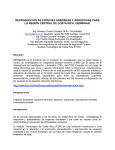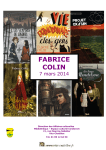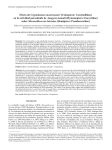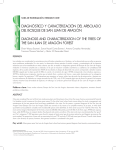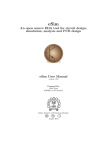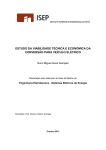Download análisis de la estructura arbórea del sistema agroforestal rusticano
Transcript
ANÁLISIS DE LA ESTRUCTURA ARBÓREA DEL SISTEMA AGROFORESTAL RUSTICANO DE CAFÉ EN SAN MIGUEL, VERACRUZ, MÉXICO ANALYSIS OF TREE STRUCTURE IN THE TRADITIONAL COFFEE AGROFORESTRY SYSTEM IN SAN MIGUEL, VERACRUZ, MÉXICO Luis Villavicencio-Enríquez1 y Juan I. Valdez-Hernández2 1 Universidad del Mar. Campus Puerto Escondido. Carretera Puerto Escondido-Sola de Vega. 71980, Puerto Escondido, Mixtepec, Oaxaca. Tel. y Fax: (01958) 5 48 33 65. ([email protected]). 2Programa Forestal. Instituto de Recursos Naturales. Colegio de Postgraduados. 56230. Montecillo, Estado de México. Tel.: (01595) 952 02 46, Fax: (01595) 952 02 56, ([email protected]) RESUMEN ABSTRACT Para conocer la riqueza, equidad e importancia de especies arbóreas, se analizó la estructura de la vegetación del sistema agroforestal (SAF) rusticano de café en la comunidad de San Miguel, Veracruz, y se la comparó con la de la selva mediana subperennifolia (SMSP) en la misma comunidad, mediante un índice de valor de importancia (IVI) y del índice de diversidad de Shannon (H'). Se establecieron al azar ocho unidades de muestreo de 20× ×50 m cada una, cuatro para el SAF rusticano de café y cuatro para la SMSP, registrándose variables dasométricas como el diámetro a la altura del pecho (DAP: 1.3 m sobre el nivel del suelo), área basal y altura total de los individuos mayores a 2.5 cm DAP. La estructura de la SMSP resultó más diversa en especies arbóreas y más estable en los valores de importancia obtenidos por especie que el SAF rusticano de café. Aunque ambos sistemas mostraron valores relativamente altos en términos de riqueza y equidad de especies, existió una diferencia significativa entre ellos (p<0.001) debido a su composición florística. In order to know the richness, equity, and importance of tree species, the vegetation structure of the traditional agro-forestry system of coffee (SAF) in the community of San Miguel, Veracruz, was analyzed and compared to that of the semievergreen tropical forest in the same community (SMSP), using an importance value index (IVI) and the Shannon diversity index (H'). Eight plots, 20× ×50 m, each were randomly established, four in the traditional SAF of coffee and four in the SMSP, recording forest variables such as the diameter at breast height (DAP: 1.3 m above soil level), basal area, and total height of those individuals greater than 2.5 cm DAP. The structure of the SMSP was more diverse in tree species and more stable in the importance value obtained per species than that of the traditional SAF of coffee. Although both systems showed relatively high values in terms of richness and equity of species, there was a significant difference between them (p<0.001) because of their floristic composition. Key words: Shannon index, importance value index, semi- Palabras clave: Índice de Shannon, índice de valor de importancia, selva mediana subperennifolia, sistemas agroforestales. evergreen tropical forest, agro-forestry system. INTRODUCTION INTRODUCCIÓN T he situation of woods and forests in the world is precarious and difficult, since every year thousands of hectares are lost due to the growth of the agricultural borderland, immoderate felling, population growth, uncontrolled cattle raising, forest fires and floods. According to calculations, the world rate of wood and forest loss has reached more than 16.1 million ha of natural vegetation per year, 15.2 million of which are located in tropical zones (FAO, 1999). In México, there was an annual loss of 678 000 ha of woodlands from 1980 to 1990 (FAO,1995), and 631 000 ha per year from 1990 to 2000 (FAO, 2002), although Masera (1996) indicate an annual loss of 615 000 ha, of which around 470 000 ha are tropical forests. Hence, it is importante to know available resources in orden, to create L a situación de los bosques y selvas en el mundo es precaria y difícil, ya que cada año se pierden miles de hectáreas por factores tales como el crecimiento de la frontera agrícola, la tala inmoderada, el crecimiento de la población, la ganadería no controlada, los incendios forestales y las inundaciones. Se calcula que la tasa mundial de pérdida de bosques y selvas asciende a más de 16.1 millones ha por año de vegetación natural, de las cuales 15.2 millones se encuentran en zonas tropicales (FAO, 1999). En México hubo una pérdida anual de 678 000 ha de cobertura forestal de 1980 a 1990 (FAO, 1995) y de Recibido: Enero, 2003. Aprobado: Julio, 2003. Publicado como ENSAYO en Agrociencia 37: 413-423. 2003. 413 414 AGROCIENCIA VOLUMEN 37, NÚMERO 4, JULIO-AGOSTO 2003 631 000 ha por año para 1990 a 2000 (FAO, 2002); aunque Masera (1996), señala una pérdida anual de 615 000 ha, de las cuales alrededor de 470 000 son de selva tropical. De aquí se deriva la importancia de cuantificar los recursos disponibles y crear estrategias de producción para un desarrollo sostenible, considerando la situación de deterioro ambiental y sus efectos en el mundo (Dhameja, 2000). La agroforestería debe ser considerada como parte de estas estrategias o como sistema de uso sostenible de la tierra (Krishnamurthy y Ávila, 1999), porque abarca condiciones naturales, ecológicas, productivas y sociales que mejoran el bienestar de la población rural al conseguir un mejor nivel de vida mediante la diversificación de sus cultivos y la conservación de los recursos naturales. Además contribuye a reducir la tasa de deforestación, conservar la biodiversidad, mantener la integridad de las cuencas hidrográficas y la estabilidad del clima (Jha, 1996). En la mayoría de las regiones tropicales donde se cultiva café de forma tradicional (como en África y Latinoamérica) se le considera como un sistema multiestrato, en el cual una diversidad de árboles con propósitos múltiples proporcionan sombra para el cultivo (Raintree, 1990). En México dichos sistemas tradicionales en las zonas productoras de café, se llevan a cabo con una gran diversidad de especies, y al igual que en los sistemas agroforestales incluyen árboles frutales, maderables y de propósito múltiple, como los de usos medicinales, sociales u ornamentales (Escamilla et al., 1994). Respecto a la estructura de la vegetación, Curtis y McIntosh (1951) desarrollaron un índice de valor de importancia que es el producto de la suma de los valores relativos de frecuencia, densidad y dominancia asignado a cada especie y, aunque discutible, al igual que los índices de diversidad por las medidas utilizadas (Phatak, 1997), puede ser útil en la caracterización de comunidades vegetales. Se ha buscado un indicador de la salud de los sistemas, y se han desarrollado índices midiendo elementos de diversidad (Magurran, 1988). Estas medidas de diversidad incluyen dos factores primordiales: a) La riqueza, o el número de especies frecuentes (o abundancia); b) la equidad (E), que indica la igualdad de abundancia de las especies. Estos conceptos y herramientas se han utilizado para estudiar policultivos y sistemas agroforestales como huertos familiares, cultivos con sombra, agrobosques y barbechos enriquecidos con especies frutales y maderables (Jha, 1994; Somarriba, 1999). Por tanto, y con el propósito de conocer la riqueza, equidad e importancia de especies arbóreas, el presente trabajo tuvo como objetivo analizar la estructura de la vegetación del sistema agroforestal (SAF) rusticano production strategies for a sustainable development, talking into account the generalized situation of environmental deterioration and its effect on the world (Dhameja, 2000). Agro-forestry must be considered as part of these strategies or as a system of sustainable land use (Krishnamurthy and Avila, 1999), because it covers natural, ecological, productive, and social conditions, which improve the welfare of the rural population, achieving a better standard of living through crop diversification and the preservation of the natural resources. Besides, it contributes to reduce deforestation rate, to conserve biodiversity, to maintain the integrity of watersheds and climatic stability (Jha, 1996). In most of the tropical regions, where coffee is cultivated in a traditional way (as in Africa and Latin America), it is considered a multi-stratum system, in which a diversity of trees with multiple purposes provide shade to the crop (Raintree, 1990). In México, these traditional systems in the coffeeproducing regions, are carried out with a great diversity of species and in the same way as in agro-forestry systems, including timber-yielding and fruit trees and those of multiple purpose, such as of medicinal, social, or ornamental use (Escamilla et al.,1994). With respect to vegetation structure, Curtis and McIntosh (1951) developed an importance value index, which is the product of the sum of the relative values of frequency, density, and dominance assigned to each species, and – though debatable – the same as the indices of diversity due to the measures utilized (Phatak, 1997), may be useful for describing vegetal communities. A health indicator of the systems has been sought, and indices have been developed by measuring elements of diversity (Magurran, 1988). These diversity measurements include two fundamental factors: a) Richness, or the number of frequent species (or abundance); b) Equity (E), which indicates how equally abundant the species occur. These concepts and tools have been utilized for studying mixed farming and agroforestry systems such as home gardens, shade crops, agroforests, and improved fallow with fruit and timberyielding species (Jha, 1994; Somarriba, 1999). Therefore, and with the purpose of knowing the richness, equity and importance of tree species, the present work had the objective of analyzing the vegetation structure of the traditional agro-forestry system (SAF) of coffee (coffea arabica L., Coffea canephora Pierre ex A. Froehner) at San Miguel, State of Veracruz, and to compare it to that of native vegetation by determining the indices of importance value and diversity of species. VILLAVICENCIO-ENRÍQUEZ y VALDEZ HERNÁNDEZ: ESTRUCTURA ARBÓREA RUSTICANO DE CAFÉ de café (Coffea arabica L., Coffea canephora Pierre ex A. Froehner) en San Miguel, Estado de Veracruz, y compararla con la de la vegetación nativa, mediante la determinación de índices de valor de importancia y de diversidad de especies. MATERIALES Y MÉTODOS Área de estudio La comunidad de San Miguel, perteneciente al municipio de Amatlán de los Reyes, Estado de Veracruz, se localiza en el km 17 de la carretera Córdoba-Mirador a una altitud de 727 m y presenta una precipitación media anual de 2500 mm, temperatura media anual de 22.5 oC y un clima tipo (A) C (m) w”o (García, 1987). La vegetación de la zona se clasifica como selva mediana subperennifolia y se caracteriza porque un porcentaje importante de los árboles (25 a 50%) pierden sus hojas en lo más acentuado de la época seca (Rzedowski, 1978). Las especies de árboles dominantes son Brosimum alicastrum Sw., Bursera simaruba (L.) Sarg., Bernoullia flammea Oliv., Robinsonella mirandae GP y Astronium graveolens Jacq. (Chiang, 1970)3. Muestreo Mediante recorridos preliminares en campo, y con la ayuda de pobladores locales, se definió un universo de 34 unidades de muestreo para el SAF rusticano de café, y de 30 para la selva mediana subperennifolia con poco disturbio (SMSP) De ellas se seleccionaron por sorteo, y de acuerdo con Cox (1981) y Somarriba (1999), ocho unidades: Cuatro para el SAF rusticano de café y cuatro para la SMSP. Las unidades de muestreo tuvieron una superficie de 1000 m2 (20×50 m) y en ellas se registró e identificó taxonómicamente todo el componente arbóreo con ayuda de los trabajos realizados sobre la flora de la Sierra de Atoyac, Veracruz, por Acevedo (1988)4, Gómez-Pompa y Nevling (1970), GómezPompa (1978) y Pennington y Sarukhán (1998), al igual que con el apoyo de la población local para la recolecta, identificación y usos de las especies. Se consideraron las siguientes variables bajo los criterios utilizados en el Centro Agronómico Tropical de Investigación y Enseñanza (Beer, 1984): Diámetro medido a la altura del pecho (DAP: 1.3 m sobre el nivel del suelo); área basal calculada a partir de la variable anterior; altura total medida utilizando un altímetro tipo Haga. Además se elaboró una curva de especies-área, que consiste en graficar el número de especies vegetales encontradas para una superficie de muestreo (Greig-Smith, 1983). Los valores de densidad, dominancia y frecuencia, así como los de valor de importancia por especie se determinaron como sigue (Stiling, 1999): 3 415 MATERIALS AND METHODS Study area The community of San Miguel belonging to the municipality of Amatlán de los Reyes, State of Veracruz, is located at km 17 of the road Córdoba-Mirador, at an altitude of 727 m and has annual mean rainfall of 2500 mm, annual mean temperature of 22.5 oC and a climate type (A) C (m) w”o (García, 1987). The vegetation of the zone is classified as semi-evergreen tropical forest and it is characterized by the fact that an important proportion of the trees (25 to 50%) shedd their leaves at the peak of the dry season (Rzedowski, 1978). The dominant tree species are Brosimum alicastrum Sw., Bursera simaruba (L.) Sarg., Bernoullia flammea Oliv., Robinsonella mirandae GP and Astronium graveolens Jacq. (Chiang, 1970)3. Sampling By preliminary field examination and assisted by local inhabitants, a universe of 34 sampling units for the traditional SAF of coffee, and 30 for the semi-evergreen tropical forest (SMSP) with little disturbance, was defined. From them, and according to Cox (1981) and Somarriba (1999), eight of them were selected by drawing: four for the traditional SAF of coffee and four for the SMSP. The sampling units had a surface of 1000 m2 (20×50m), and within them, all the trees were registered and taxonomically identified, based on the studies about the flora of the Sierra de Atoyac, Veracruz, carried out by Acevedo (1988)4, Gómez-Pompa and Nevling (1970), Gómez-Pompa (1978), and Pennington and Sarukhán (1998), and supported by the local population for harvesting, identification, and utilization of the species. The following variables, under the criteria utilized at the Centro Agronómico Tropical de Investigación y Enseñanza (Tropical Agronomic Center of Research and Teaching), were considered (Beer, 1984): diameter measured at breast height (DAP: 1.3 m above soil level); basal area calculated from the previous variable; total height measured with a Haga type altimeter. Besides, a curve of species-area was drawn, which is the graphical expression of the number of plant species found for one sampling surface (GreigSmith, 1983) The values of density, dominance, and frequency, as well as the importance value per species were determined as below (Stiling, 1999): Density = Number of individuals Sampled area Chiang, F. 1970. La vegetación de Córdoba, Veracruz. Tesis Profesional. Facultad de Ciencias. UNAM. México. 37 p. Acevedo, R. R. 1988. La vegetación en la Sierra de Atoyac, Veracruz. México. Tesis de Licenciatura. Universidad Veracruzana. Xalapa, Veracruz. México. 105 p. 4 416 AGROCIENCIA VOLUMEN 37, NÚMERO 4, JULIO-AGOSTO 2003 Densidad = Número de individuos Density per species ×100 Relative density = Area muestreada Density of all species Densidad por especie ×100 Densidad relativa = Densidad de todas las especies Dominancia = Dominance = Total of basal area Sampled area Total del área basal Dominance per specie Area muestreada ×100 Relative dominance = Dominance of all species Dominancia por especie ×100 Dominancia relativa = Dominancia de todas las especies Sampling units in which the species is present Unidades de muestreo en que está presente la especie Frecuency = Total number of sampling units Frecuencia = Número total de unidades de muestreo Frecuency per specie ×100 Relative frecuency = Frecuency of all species Frecuencia por especie ×100 Frecuencia relativa = Frecuencia de todas las especies Importance value=Relative density+Relative dominance+Relative frequency Valor de importancia=Densidad relativa+Dominancia relativa+ Frecuencia relativa El índice de diversidad de Shannon (H’) se calculó con la The Shannon diversity index (H’) was calculated with the following equation: siguiente ecuación: H '=−∑ pi ln pi where pi = proportion (or relative abundance) of each species in donde pi = proporción (o abundancia relativa) de cada especie en the population. la población. Equity (E) was calculated with the following equation: La equidad (E) se calculó con la siguiente ecuación: E= H' E= =− pi ln pi ∑ ln S H' ∑ ln S =− pi ln pi where S = total number of species. donde S = número total de especies. Para determinar diferencias significativas en la diversidad de especies arbóreas entre el SAF rusticano de café y la selva mediana subperennifolia (SMSP), se utilizó el método de Hutcheson (Magurran, 1988) para calcular el valor de t modificado: a fa t = H '1−H '2 / VarH '1+VarH '2 f 1/ 2 donde H'1 = valor del índice de diversidad de Shannon para SAF; H'2 = valor del índice de diversidad de Shannon para SMSP; Var H'1 = varianza del índice de diversidad de Shannon en SAF; Var H'2 = varianza del índice de diversidad de Shannon en SMSP; y los grados de libertad (gl) utilizando: To determine significant differences for diversity of tree species between the traditional SAF of coffee and the semi-evergreen tropical forest (SMSP), the Hutcheson method (Magurran, 1988) was used to calculate the modified t value: a fa t = H '1−H '2 / VarH '1+VarH '2 f 1/ 2 where H'1 = value of the Shannon index of diversity for SAF; H'2 = value of the Shannon index of diversity for SMSP; Var H'1 = variance of the Shannon index of diversity in SAF; Var H'2 = variance of Shannon index of diversity in SMSP and the degrees of freedom (gl) utilizing : VILLAVICENCIO-ENRÍQUEZ y VALDEZ HERNÁNDEZ: ESTRUCTURA ARBÓREA RUSTICANO DE CAFÉ aVarH ' +VarH ' f FH aVarH ' f / N IK +FH aVarH ' f 2 gl = 1 2 2 2 1 1 2 2 / N2 IK La varianza de las H' de cada sistema se determinó mediante la ecuación: VarH '= ∑ pi aln pif − c∑ pi ln pih 2 N 2 − S −1 2N 2 Por último, y para conocer la similitud florística entre los sistemas estudiados, se obtuvo el coeficiente de Jaccard (Cj), que se basa en la relación presencia-ausencia entre el número de especies en cada sistema y el número total de especies (Stiling, 1999): a Cj = C / A+ B− C aVarH ' +VarH ' f FH aVarH ' f / N IK +FH aVarH ' f 417 gl = 1 2 2 1 1 2 / N2 IK The variance of H' for each system was determined with the equation: VarH '= ∑ pi aln pif − c∑ pi ln pih 2 N 2 − S −1 2N2 Last, in order to know the species similarity among the studied systems, the Jaccard coefficient (Cj) was obtained, which is based on the presence-absence relationship between the number of species in each system and the total number of species (Stiling, 1999): f a Cj = C / A+ B− C donde C = número de especies comunes a ambos sistemas; A = número de especies encontradas en el sistema A; B = número de especies encontradas en el sistema B. 2 f where C = number of species found in both systems; A = number of species found in system A; B = number of species found in system B. RESULTADOS Y DISCUSIÓN RESULTS AND DISCUSSION 30 A total of 81 native, secondary and exotic tree species were registered, 62 of which were present in the traditional SAF of coffee, and 66 in the semi-evergreen tropical forest (SMSP), as can be seen in Figure 1. The Jaccard coefficient (Cj) for the two studied systems was 0.58, in other words, there is 58% of species similarity and 42% of different species between both systems. Cj = C / (A+B−C) = 47 / (62+66−47) = 0.58 20 70 SMSP especies SAF comunes 10 0 1 2 donde C = número de a ambos sistemas; A = número de especies encontradas en el SAF; B = número en 5 6 encontradas 7 8 9 la SMSP. 3 4de especies 2 Area (× 100 m ) Este valor de similitud es muy alto en comparación con lo registrado por Guiracocha et al. (2001) en Talamanca, Costa Rica, para un bosque húmedo tropical y un SAF tradicional de cacao con sombra, que compartieron sólo 5% de especies arbóreas. Selva mediana subperennifolia Se compone principalmente de especies típicas de esta selva como Cedrela odorata L., Brosimum alicastrum, Bursera simaruba, Roupala montana Aublet, Trichilia hirta L. y Juglans sp., entre otras; así como de aquellas consideradas parte de la vegetación secundaria como Trichilia havanensis Jacq., Piper hispidum Sw., 60 Número de especies Número de especies Se registró un total de 81 especies arbóreas pertenecientes a vegetación nativa, secundarias y exóticas, de 70 2 cuales +VarH aVarH '1las '2 f 62 estuvieron presentes en el SAF rusticano gl = café y 662 en la selva mediana subperennifolia (SMSP), 60 FH aVarH '1 f2 / N1 IKde + FH aVarH '2 f / N2 IK como se aprecia en la Figura 1. 50 El coeficiente de Jaccard (Cj) para los dos sistemas estudiados fue 0.58; es decir, existe 58% de similitud florística 40 y 42% de especies distintas entre ambos sistemas. 50 40 30 20 SMSP SAF 10 0 1 2 3 5 6 4 2 Area (× 100 m ) 7 8 9 Figura 1. Curva especies-área del SAF rusticano de café (SAF) y de la selva mediana subperennifolia (SMSP) en San Miguel, Veracruz. Figure 1. Species- area curve of the traditional agro-forestry system of coffee (SAF) and of the semi-evergreen tropical forest (SMSP) at San Miguel, Veracruz. 418 AGROCIENCIA VOLUMEN 37, NÚMERO 4, JULIO-AGOSTO 2003 Bauhinia divaricata L. y Cupania dentata Moc. & Sessé ex DC. Las especies típicas de selva que tuvieron un valor de importancia relevante dentro de este sistema fueron Dipholis minutiflora Pittier, que fue la especie más importante en presencia en las cuatro unidades de muestreo estudiadas, seguida por Robinsonella mirandae, Ficus tecolutensis (Liebm.) Miq. y Croton aff. niveus Jacq. Tres especies representativas de vegetación secundaria tuvieron altos valores de importancia: Cordia alliodora (Ruiz & Pav.) Oken, Bursera simaruba y Piper hispidum (Cuadro 1). La presencia de Bursera simaruba puede ser un buen indicador de la magnitud de intervención en este sistema, ya que Piper hispidum, al igual que Bauhinia divaricata o Cupania dentata, forman parte de los estratos bajo e intermedio de la vegetación secundaria. De acuerdo con los datos, la presencia de vegetación secundaria representa un peso importante en la estructura del dosel de los dos sistemas. En cuanto a las especies maderables de importancia, Cedrela odorata, Mastichodendron capiri (A. DC.) Cron., Juglans sp. y Roupala montana mostraron una baja presencia e importancia en los sistemas, a diferencia de Dipholis minutiflora y Cordia alliodora, las cuales son conservadas debido a su valor comercial. El resto de las especies parece que han tenido un uso excesivo, y sin planes de manejo que promuevan su regeneración. Cj = C / ( A+B- C) = 47 / (62+66-47) = 0.58 where C = number of species found in both systems; A = number of species found in the SAF; B = number of species found in the SMSP. This value of similarity is very high, compared to that registered by Guiracocha et al.(2001) in Talamanca, Costa Rica, for a humid tropical forest and a traditional SAF of cacao under shade, which shared only 5% of tree species. Semi-evergreen tropical forest This consists mainly of typical species of this forest, such as Cedrela odorata L., Brosimum alicastrum, Bursera simaruba, Roupala montana Aublet, Trichilia hirta L., and Juglans sp. among others, as well as of those considered part of the secondary vegetation like Trichilia havanensis Jacq., Piper hispidum Sw., Bauhinia divaricata L., and Cupania dentata Moc.& Sessé ex DC. The typical species of tropical forest, which reached an outstanding importance within this system, were Dipholis minutiflora Pittier, being the most important species with respect to presence in the four sampling units studied, followed by Robinsonella mirandae, Ficus tecolutensis (Liebm.) Miq., and Croton aff. niveus Jacq. Three species, representative of secondary vegetation, obtained high importance values: Cordia alliodora Cuadro 1. Especies arbóreas con los mayores valores de importancia (IVI) obtenidos en las unidades de muestreo (1-4) de selva mediana subperennifolia (SMSP). Table 1. Tree species with the highest importance values (IVI) obtained in sampling units (1-4) of the semi-evergreen tropical forest (SMSP). Unidad de muestreo 1 Dipholis minutiflora Pittier Cordia alliodora (Ruiz & Pav.) Oken Robinsonella mirandae GP Bursera simaruba (L.) Sarg. Piper hispidum Sw. Croton aff. niveus Jacq. Ficus tecolutensis (Liebm.) Miq. Trichilia hirta L. “Zopilote” Coccoloba hirtella Lund. Unidad de muestreo 3 Piper hispidum Robinsonella mirandae Dipholis minutiflora Inga vera Willd. Cupania dentata Cordia alliodora Croton aff. niveus Inga paterna Harms. Lippia umbellata Cav. Trichilia havanensis Jacq. IVI 23.77 19.33 14.71 13.71 13.23 12.35 12.35 12.20 11.88 11.01 IVI 20.07 14.55 13.90 13.58 13.54 12.34 11.78 11.72 9.66 8.74 Unidad de muestreo 2 Ficus tecolutensis Dipholis minutiflora Cordia alliodora Croton aff. niveus Robinsonella mirandae Bellucia grossularioides (L.) Triana Heliocarpus appendiculatus Turcz. Cupania dentata Moc. & Sessé ex DC. Prunus brachybotrya Zucc. Coccoloba hirtella Unidad de muestreo 4 Bursera simaruba Piper hispidum Dipholis minutiflora Bauhinia divaricata L. Cordia alliodora Mastichodendron capiri (A. DC.) Cron. Lonchocarpus rugosus Benth. Zuelania guidonia (Sw.) Britt. & Millsp. Bernoullia flammea Oliv. Lucuma campechiana H.B.K. IVI 20.08 18.11 17.70 15.57 14.51 12.94 12.84 11.50 10.30 9.78 IVI 28.30 20.36 18.84 15.67 14.32 13.09 12.03 11.35 9.98 9.73 VILLAVICENCIO-ENRÍQUEZ y VALDEZ HERNÁNDEZ: ESTRUCTURA ARBÓREA RUSTICANO DE CAFÉ SAF rusticano de café La composición florística del dosel en el sistema presentó especies típicas de selva mediana subperennifolia como Robinsonella mirandae, Bursera simaruba, Bernoullia flammea, Lucuma campechiana H. B. K. y Astroniums graveolens; especies representativas de vegetación secundaria, como Cecropia obtusifolia Bertol., Spondias mombin L., Trichilia havanensis y Guazuma ulmifolia Lam.; y especies exóticas como Citrus sinensis (L.) Osbeck, Citrus reticulata Blanco y Mangifera indica L. Las especies que alcanzaron los mayores valores de importancia (IVI) en el sistema fueron Bursera simaruba, Cordia alliodora, Dipholis minutiflora y Vatairea lundellii (Standl.) Killip ex Record (Cuadro 2). Aunque la presencia de especies típicas de la selva fue evidente con árboles como Ficus tecolutensis, Alchornea latifolia Sw. y Vatairea lundellii, el IVI fue mayor para árboles representativos de vegetación secundaria como Bursera simaruba, Cordia alliodora, Cupania dentata y Bauhinia divaricata. Esta presencia puede ser un indicador del cambio que los cafetales de tipo rusticano tienen en su estructura. Estos cambios se producen mediante la sustitución de componentes arbóreos con uso maderable, por las maderas blandas. El IVI de Bursera simaruba alcanzó un valor cercano a 60 en la unidad de muestreo 8, debido posiblemente a que la utilización de árboles maderables como 419 (Ruiz & Pav.) Oken, Bursera simaruba, and Piper hispidum (Table 1). The presence of Bursera simaruba may be a good indicator of the magnitude of intervention in this system, since Piper hispidum as well as Bauhinia divaricata or Cupania dentata, form part of the low and intermediate layer of secondary vegetation. According to the data, the presence of secondary vegetation is an important factor in the canopy structure of the two systems. As for the timber-yielding species of importance, Cedrela odorata, Mastichodendron capiri (A. DC.) Cron., Juglans sp., and Roupala montana had low presence and importance in the systems, unlike Dipholis minutiflora and Cordia alliodora, which are preserved because of their commercial value. For the rest of the species, it seems that they have been exploited too much, and without management plans to promote their regeneration. The traditional SAF of coffee The floristic composition of the canopy in the system showed typical species of the semi-evergreen tropical forest, such as Robinsonella mirandae, Bursera simaruba, Bernoullia flammea,Lucuma campechiana H.B.K., and Astronium graveolens; species representative of secondary vegetation, as Cecropia obtusifolia Bertol., Spondias mombin L., Trichilia havanensis, and Guazuma ulmifolia Lam.; and exotic species like Citrus sinensis Cuadro 2. Especies arbóreas con los mayores valores de importancia (IVI) obtenidos en las unidades de muestreo (5-8) del SAF rusticano de café. Table 2. Tree species with the highest importance values (IVI) obtained in sampling units (5-8) of the traditional SAF of coffee. Unidad de muestreo 5 Bursera simaruba (L.) Sarg. Dipholis minutiflora Pittier Bellucia grossularioides (L.) Triana Vatairea lundellii (Standl.) Killip ex Rec. Cupania dentata Moc. & Sessé ex DC. Bauhinia divaricata L. “Montecillo” Mastichodendron capiri (A. DC.) Cron. Bernoullia flamea Oliv. Lonchocarpus rugosus Benth. Unidad de muestreo 7 Dipholis minutiflora Bursera simaruba Bauhinia divaricata Cordia alliodora Mastichodendron capiri Bellucia grossularioides Piper hispidum Sw. Lonchocarpus rugosus Astronium graveolens Jacq. Robinsonella mirandae IVI 28.48 26.44 22.57 20.42 15.60 13.33 11.98 10.72 8.93 8.56 IVI 33.27 27.74 15.59 15.38 13.67 12.92 12.74 12.07 10.60 10.38 Unidad de muestreo 6 Cordia alliodora (Ruiz & Pav.) Oken Dipholis minutiflora Bursera simaruba “Coralillo” Robinsonella mirandae GP Vatairea lundellii Cedrela odorata L. Cupania dentata Bauhinia divaricata Zuelania guidonia (Sw.) Britt. & Millsp. Unidad de muestreo 8 Bursera simaruba Cordia alliodora Cupania dentata Vatairea lundellii Bauhinia divaricata “Coralillo” Robinsonella mirandae Lonchocarpus rugosus Bernoullia flammea Dipholis minutiflora IVI 33.62 21.63 21.42 18.42 15.91 13.64 13.14 12.70 11.63 10.65 IVI 59.67 48.10 38.26 18.64 16.93 14.88 14.63 13.58 11.66 7.69 420 AGROCIENCIA VOLUMEN 37, NÚMERO 4, JULIO-AGOSTO 2003 Dipholis minutiflora ha sido mayor que en el resto de las unidades de muestreo (Cuadro 2). Esta unidad de muestreo presenta un mayor contraste en su estructura, ya que tiene los valores más altos y más bajos calculados para el sistema. El resto presenta una distribución más homogénea de especies, sobre todo en las unidades de muestreo 6 y 7. Aunque todas las unidades de muestreo presentan desbalance en su estructura arbórea, aquéllas con los valores más dispares en IVI son las muestreadas en el SAF, dado que han experimentado un mayor grado de disturbio por el hombre mediante la introducción de especies exóticas (p.ej. Mangifera indica y Citrus spp.) y la utilización de especies maderables componentes de la selva (p.ej. Cedrela odorata y Juglans sp.). Diversidad de especies Los valores del índice de diversidad (H’) y equidad (E) fueron mayores por unidad de muestreo y en promedio para el sistema selva mediana subperennifolia, en comparación con los obtenidos en el SAF rusticano de café (Cuadro 3). Esto indica una mayor riqueza de especies y una distribución más equitativa de las mismas en las unidades muestreadas del primer sistema. Estos valores son comunes para las selvas, como ha sido demostrado por Phatak et al. (1993), Saï y Manesh (1986) y Kumar (1990) en la India; y por Godínez-Ibarra y López-Mata (2002) en el centro del Estado de Veracruz, México. Se realizó la prueba de homogeneidad de varianzas de Hartley (Steel y Torrie, 1986) para los sistemas estudiados, y se encontró homocedasticidad. Cuadro 3. Índice de Shannon (H') y valores de equidad (E) y varianza (V) en las unidades de muestreo de selva mediana subperennifolia (SMSP) y del SAF rusticano de café (SAF). Table 3. Shannon index (H') and values of equity (E) and variance (V) in the sampling units of semi-evergreen tropical forest (SMSP) and traditional agro-forestry system of coffee (SAF). Unidad de muestreo (SMSP) 1 2 3 4 Promedio Unidad de muestreo (SAF) 5 6 7 8 Promedio H' E 3.56 3.58 3.47 3.40 3.50 0.73 0.77 0.73 0.73 0.74 H' E 3.36 3.36 3.44 2.51 3.17 0.65 0.67 0.66 0.57 0.64 V 0.0029 0.0021 0.0041 0.0032 0.0031 V 0.0046 0.0036 0.0026 0.0089 0.0049 (L.) Osbeck, Citrus reticulata Blanco, and Mangifera indica L.. The species that reached the highest importance values (IVI) in the system were Bursera simaruba, Cordia alliodora, Dipholis minutiflora, and Vatairea lundellii (Standl.) Killip ex Record (Table 2) were outstanding. Though the presence of typical species of the tropical forest was evident, with trees like Ficus tecolutensis, Alchornea latifolia Sw., and Vatairea lundellii, the IVI was greater for trees, representative of secondary vegetation, like Bursera simaruba, Cordia alliodora, Cupania dentata, and Bauhinia divaricata. They may be an indicator of the structural change that coffee plantations of the traditional type are undergoing. These changes occur at substituting trees of timber-yielding use by the softwood. The IVI of Bursera simaruba reached a value close to 60 in sampling unit 8, possibly due to the fact that timber-yielding trees like Dipholis minutiflora have been utilized to a greater extent than in the other sampling units (Table 2). This sampling unit shows greater contrast in its structure, since it has the highest and the lowest values calculated for the system. The rest presents a more homogeneous distribution of species, especially in sampling units 6 and 7. Though all the sampling units show a disequilibrium in their tree structure, those with the most uneven values in IVI are the ones sampled in the SAF, as they have suffered a higher degree of disturbance by man through the introduction of exotic species (e.g. Mangifera indica and Citrus spp.) and the utilization of timber-yielding species, components of the tropical forest (e.g. Cedrela odorata and Juglans sp.). Diversity of species The values of the index of diversity (H’) and equity (E) were greater per sampling unit and on average for the system of semi-evergreen tropical forest, than the ones obtained in the traditional SAF of coffee (Table 3). This indicates greater richness of species and a more equitable distribution of them in the sampled units of the first system. These values are common for tropical forests, as it has been shown by Phatak et al. (1993), Saï and Manesh (1986) and Kumar (1990) in India, and by Godínez-Ibarra and López-Mata (2002) in the center of Veracruz, México. The Hartley homogeneity test of variances (Steel and Torrie, 1986) was carried out for the studied systems, and homoscedasticity was found. According to the value calculated in the t-test (t=3.75, gl=1035.4), the systems are different (p<0.001) in their diversity values of tree species. This supports the result obtained with the Jaccard similarity coefficient VILLAVICENCIO-ENRÍQUEZ y VALDEZ HERNÁNDEZ: ESTRUCTURA ARBÓREA RUSTICANO DE CAFÉ De acuerdo con el valor calculado en la prueba de t (t=3.75, gl=1035.4), los sistemas son diferentes (p<0.001) en sus valores de diversidad de especies arbóreas, Esto apoya el resultado obtenido con el coeficiente de similitud de Jaccard, que mostró diferencias hasta de 42% del total de especies entre sistemas. 421 which showed differences up to 42% of the total of species between systems. The value of t was calculated as follows: t=(H'1−H'2 )/(Var H'1+Var H'2)½ = (3.1652−3.5021) / (0.004954+0.003110)½=3.75 El valor de t se calculó como sigue: t=(H'1−H'2 )/(Var H'1+Var c'2)½ = (3.1652−3.5021) / (0.004954+0.003110)½ = 3.75 donde H'1=valor del índice de diversidad de Shannon para SAF; H'2=valor del índice de diversidad de Shannon para SMSP; Var H'1=varianza para el índice de diversidad de Shannon en SAF; Var H'2=varianza para el índice de diversidad de Shannon en SMSP; y los grados de libertad se calcularon con la ecuación: aVarH ' +VarH ' f gl = FH eaVarH ' f / N j+eaVarH ' f a0.004954 +0.003110f FH ea0.004954f / 590j +ea0.003110f 2 2 1 1 aVarH ' +VarH ' f gl = FH eaVarH' f / N j +eaVarH ' f a0.004954 +0.003110f FH ea0.004954f / 590j+ea0.003110f 2 1 2 2 1 1 2 2 / N2 jIK = jIK = 1035.36 2 2 1 where H'1=value of the Shannon diversity index for SAF; H'2=value of the Shannon diversity index for SMSP; Var H'1=variance for the Shannon diversity index in SAF; VarH'2=variance for the Shannon diversity index in SMSP; and the degrees of freedom utilizing: 2 2 = / N jI K 2 2 2 / 456 2 2 2 / 456 jIK = 1035.4 aVarH ' +VarH ' f donde N =número total de individuos en SAF; gl = N =número total de individuos FH eaVarH ' f / N j+eaVarH ' f / N jIK = en SMSP. No obstante poseer una menor diversidad de espea0.004954 f la selva mediana 0.003110que cies+arbóreas = 1035.4 subperennifolia en FH ea0.004954f / 590 I estudio, el SAF rusticano de j +ea0.003110f / 456j café conserva un gran número de especies propias Kde la vegetación nativa. Pero 2 1 2 1 2 1 2 2 1 2 2 2 2 2 las de mayor importancia son las identificadas como vegetación secundaria, con una composición florística en cierta medida protegida por los productores locales, ya que dichas especies poseen un mayor valor maderable (p.ej. Cordia alliodora). La diversidad de especies arbóreas en una muestra de selva mediana subperennifolia del centro de Veracruz, con escasa intervención humana (Godínez-Ibarra y López-Mata, 2002), fue similar (H’=3.15) al SAF rusticano de café del presente estudio (H’=3.16). Por tanto, este sistema, donde la única labor es el control de la maleza (ocasionalmente también la poda) y el cultivo se estableció hace unos 30 años, sería una etapa avanzada de la sucesión secundaria de la selva en el área de estudio. Para conocer la contribución del SAF rusticano de café en el mantenimiento de esta etapa sucesional de la vegetación, así como un posible avance o retroceso a otras etapas, es necesario evaluar la abundancia, crecimiento y supervivencia de plántulas y juveniles de las where N1= total number of individuals in SAF; N2 = total number of individuals in SMSP. Although the traditional SAF of coffee has less diversity of tree species than the semi-evergreen tropical forest, it conserves a great many species characteristic for native vegetation. Nevertheless, the most important species are those identified as secondary vegetation, with a floristic composition, protected to a certain extent by the local producers, since these species possess a higher timber-yielding value (e.g. Cordia alliodora). The diversity of tree species in a sample of semievergreen tropical forest in the center of Veracruz, with limited human intervention (Godínez-Ibarra and LópezMata, 2002), was similar (H'=3.15) to the traditional SAF of coffee of the present study (H'=3.16). Therefore, this system, where the only labor is weed control (occasionally also pruning), and the crop was established about 30 years ago, would be an advanced phase of secondary succession of tropical forest in the study area. To know the contribution of the traditional SAF of coffee in the maintenance of this successional phase of vegetation, as well as of a possible advance or retrogression to other phases, it is necessary to evaluate abundance, growth, and survival of seedlings and saplings of the tree species in the studied systems. This has been done in the northwest of Ecuador by Velásquez Runk (1998), and in the south of India by Uma Shankar et al. (1998). 422 AGROCIENCIA VOLUMEN 37, NÚMERO 4, JULIO-AGOSTO 2003 especies arbóreas en los sistemas estudiados. Esto se ha hecho en el noroeste de Ecuador por Velásquez Runk (1998), y en el sur de la India por Uma Shankar et al. (1998). CONCLUSIONES La estructura arbórea en las unidades de muestreo compuestas por selva mediana subperennifolia resultó más rica en diversidad de especies y más estable en los valores de importancia de sus componentes, que aquella encontrada en las unidades de muestreo del SAF rusticano de café. Los índices de diversidad mostraron que, aunque los valores fueron relativamente altos en riqueza y equidad de especies para ambos sistemas, existió una diferencia significativa entre el SAF rusticano de café (menor valor) y la selva mediana subperennifolia (mayor valor) debida a la flora arbórea que los caracterizó. AGRADECIMIENTOS Al Consejo Nacional de Ciencia y Tecnología (CONACYT) por la beca otorgada al primer autor para realizar estudios de Maestría en el Colegio de Postgraduados (CP), al Dr. Lauro Bucio del Campus Córdoba del CP por su apoyo en el trabajo de campo, al Dr. Humberto Vaquera del Programa de Estadística del CP por su ayuda en el análisis estadístico, y a los revisores y al editor de Agrociencia por sus comentarios y sugerencias al documento. LITERATURA CITADA Beer J. 1984. Normas para la investigación silvicultural de especies para leña. Serie Técnica. Manual Técnico No. 1. CATIE. Turrialba, Costa Rica. pp: 18-33. Cox, W. G. 1981. Laboratory manual of general ecology. William C. Brown Co. Publishers. Iowa, USA. 230 p. Curtis, J. T., and R. P. McIntosh. 1951. An upland forest continuum in the prairie-forest border region of Wisconsin. Ecology 32: 476-496. Dhameja, S. K. 2000. Environmental engineering and management. S. K. Cataría and Sons Publishers. New Delhi, India. 385 p. Escamilla, P. E., A. L. Licona, S. Díaz, y H. Santoyo. 1994. Los sistemas de producción de café en el centro de Veracruz, México. Un análisis tecnológico. CIESTAAM, (DCR), CRUO, Universidad Autónoma Chapingo. México. 75 p. FAO. 1995. Forest resources assessment 1990. Tropical countries. FAO Forestry Paper 112. Rome, Italy. 112 p. FAO. 1999. La situación de los bosques y selvas en el mundo. Roma, Italia. 176 p. FAO. 2002. Global forest resources assessment 2000. Main report. FAO Forestry Paper 140. Rome, Italy. 512 p. García, E. 1987. Modificaciones al Sistema Climático de Köppen. 4ª Edición. INEGI. México. 217 p. Godínez-Ibarra, O., y L. López-Mata. 2002. Estructura, composición, riqueza y diversidad de árboles en tres muestras de selva mediana subperennifolia. Anales del Instituto de Biología, Universidad Nacional Autónoma de México, Serie Botánica 73 (2): 283-314. CONCLUSIONS The tree structure in the sampling units consisting of semi-evergreen tropical forest turned out to be richer in diversity of species, and more stable in importance values of its components, than that found in the sampling units of traditional SAF of coffee. The diversity indices showed that in spite of their values being relatively high with respect to richness and equity of species for both systems, there was a significant difference between traditional SAF of coffee (less value) and semi-evergreen tropical forest (greater value) due to their characteristic tree flora. —End of the English version— Gómez-Pompa, A. 1978. Ecología de la Vegetación del Estado de Veracruz. Editorial Continental. México. 75 p. Gómez-Pompa, A. y L. Nevling Jr. 1970. La flora de Veracruz. Instituto de Biología de la UNAM. México. 4 (1): 1-2. Greig-Smith, P. 1983. Quantitative Plant Ecology. 3rd edition. University of California Press. Berkeley, CA. 347 p. Guiracocha, G., C. Harvey, E. Somarriba, U. Krauss, y E. Carrillo. 2001. Conservación de la biodiversidad en sistemas agroforestales con cacao y banano en Talamanca, Costa Rica. Agroforestería en las Américas 8 (30): 7-11. Jha, L. K. 1994. Advances in Agroforestry. APH Publishing Corporation. New Delhi, India. 670 p. Jha, L. K. 1996. Forestry for Rural Development. APH Publishing Corporation. New Delhi, India. 283 p. Krishnamurthy, L., y M. Ávila. 1999. Agroforestería Básica. PNUMA-FAO. Red de Información Ambiental. México. 340 p. Kumar, S. R. 1990. Comparison of four diversity indices. J. Tropical Forestry 6 (13): 222-232. Magurran, A. E. 1988. Ecological Diversity and its Measurement. Croom Helm. London. 179 p. Masera, O. 1996. Deforestación y degradación forestal en México. Documento de trabajo Nº 19. SEMARNAP. Poder Ejecutivo Federal. Programa Forestal y de Suelo 1995-2000. México. Pennington, T. D., y J. Sarukhán. 1998. Arboles Tropicales de México. Fondo de Cultura Económica, ONU-FAO, UNAM. México. 521 p. Phatak, N. 1997. Agroforestry and environmental protection: A short critique. Indian J. Forestry 20 (1): 49-53. Phatak, N., S. Bargali, and S. Rawat. 1993. Analysis of woody vegetation in high elevation oak forest of central Himalaya. The Indian Forester 119 (9): 723-731. Raintree, J.B. 1990. Theory and practice of agroforestry diagnosis and design. In: Agroforestry: Classification and Management. MacDicken, K.G., and N.T. Vergara (eds.). John Wiley & Sons. New York, USA. pp: 58-97. Rzedowski, J. 1978. Vegetación de México. Limusa. México. 432 p. Saï, V. S., and M. Manesh. 1986. Comparison of some indices of species diversity in the estimation of the actual diversity in a tropical forest. A case study. Tropical Ecology 27 (2): 195201. Somarriba, E. 1999. Diversidad Shannon. Agroforestería en las Américas 6 (23): 72-74. VILLAVICENCIO-ENRÍQUEZ y VALDEZ HERNÁNDEZ: ESTRUCTURA ARBÓREA RUSTICANO DE CAFÉ Steel, R., y J. H. Torrie. 1986. Bioestadística: Principios y Procedimientos. 2ª Edición. Mc Graw-Hill. México. 613 p. Stiling, P. 1999. Ecology; Theories and Applications. 3rd edition. Prentice Hall. New Jersey, USA. 840 p. Uma Shankar, K.S. Murali, R. Uma Shaanker, K.N. Ganeshaiah, and K.S. Bawa. 1998. Extraction of non-timber forest products in the forests of Biligiri Rangan Hills, India. 4. Impact on 423 floristic diversity and population structure in a thorn scrub forest. Economic Botany 52 (3): 302-315. Velásquez Runk, J. 1998. Productivity and sustainability of a vegetable ivory palm (Phytelephas aequatorialis, Arecaceae) under three management regimes in northwestern Ecuador. Economic Botany 52 (2): 168-182.











